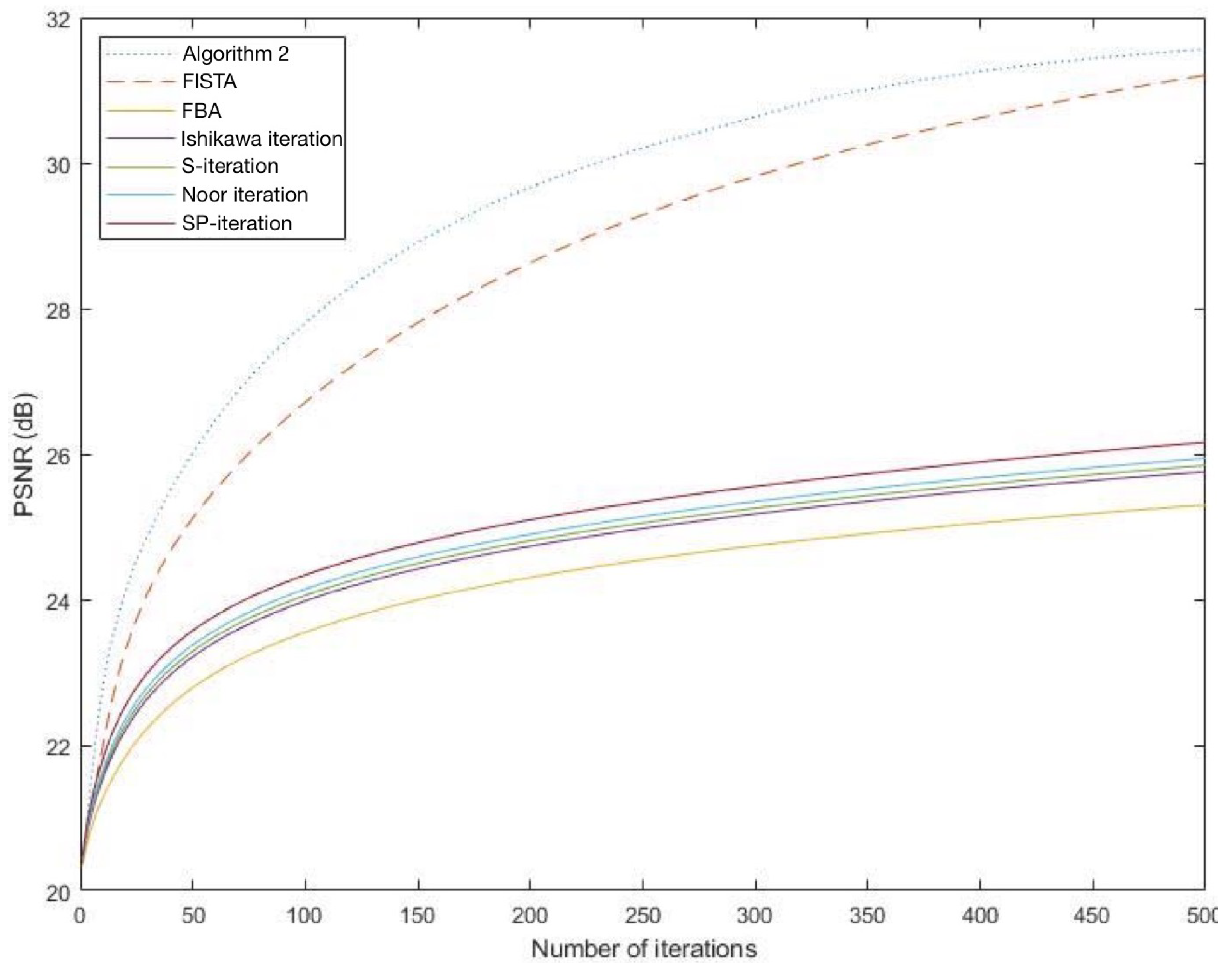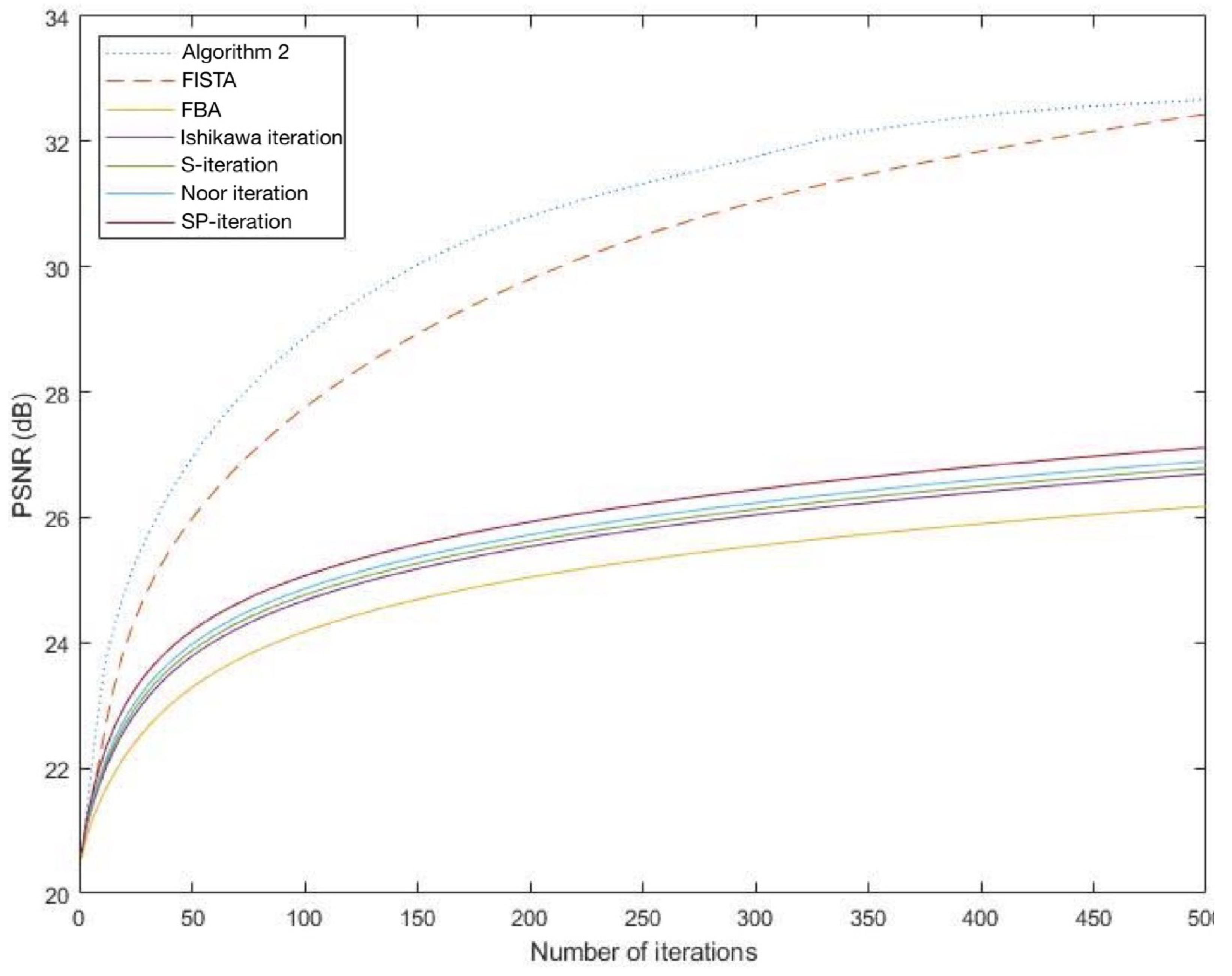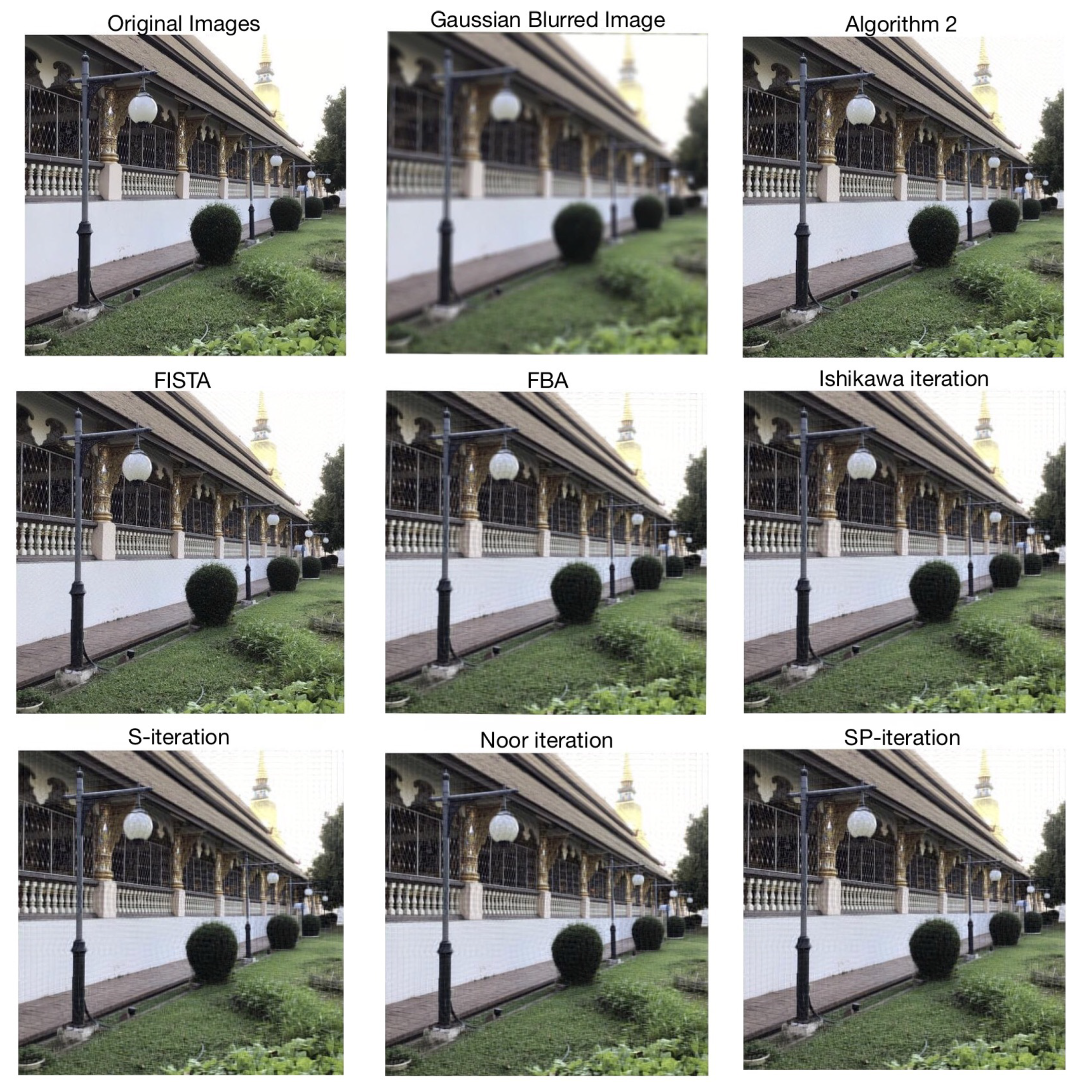1. Introduction
Let
H be a real Hilbert space with the norm
and
C be a nonempty closed convex subset of
A mapping
is said to be
nonexpansive if it satisfies the following symmetric contractive-type condition:
for all
; see [
1].
The notation of the set of all fixed points of T is
Many mathematicians have studied iterative schemes for finding the approximate fixed-point theorem of nonexpansive mappings over many years; see [
2,
3]. One of these is the Picard iteration process, which is well known and popular. Picard’s iteration process is defined by
where
and an initial point
is randomly selected.
The iterative process of Picard has been developed extensively by many mathematicians, as follows:
Mann iteration process [
4] is defined by
where
and an initial point
is randomly selected and
is a sequence in
.
Ishikawa iteration process [
5] is defined by
where
and an initial point
is randomly selected and
,
are sequences in
.
S-iteration process [
6] is defined by
where
and an initial point
is randomly selected and
,
are sequences in
. We know that the S-iteration process (
3) is independent of Mann and Ishikawa iterative schemes and converges quicker than both; see [
6].
Noor iteration process [
7] is defined by
where
and an initial point
is randomly selected and
,
are sequences in
. We can see that Mann and Ishikawa iterations are special cases of the Noor iteration.
SP-iteration process [
8] is defined by
where
and an initial point
is randomly selected and
,
are sequences in
. We know that Mann, Ishikawa, Noor and SP-iterations are equivalent and the SP-iteration converges faster than the other; see [
8].
The fixed-point theory is a rapidly growing field of research because of its many applications. It has been found that a self-map on a set admits a fixed point under specific conditions. One of the recent generalizations is due to Jachymiski.
Jachymski [
9] proved some generalizations of the Banach contraction principle in a complete metric space endowed with a directed graph using a combination of fixed-point theory and graph theory. In Banach spaces with a graph, Aleomraninejad et al. [
10] proposed an iterative scheme for
G-contraction and
G-nonexpansive mappings.
G-monotone nonexpansive multivalued mappings on hyperbolic metric spaces endowed with graphs were defined by Alfuraidan and Khamsi [
11]. On a Banach space with a directed graph, Alfuraidan [
12] showed the existence of fixed points of monotone nonexpansive mappings. For
G-nonexpansive mappings in Hilbert spaces with a graph, Tiammee et al. [
13] demonstrated Browder’s convergence theorem and a strong convergence theorem of the Halpern iterative scheme. The convergence theorem of the three-step iteration approach for solving general variational inequality problems was investigated by Noor [
7]. According to [
14,
15,
16,
17], the three-step iterative method gives better numerical results than the one-step and two-step approximate iterative methods. For approximating common fixed points of a finite family of
G-nonexpansive mappings, Suantai et al. [
18] combined the shrinking projection with the parallel monotone hybrid method. Additionally, they used a graph to derive a strong convergence theorem in Hilbert spaces under certain conditions and applied it to signal recovery. There is also research related to the application of some fixed-point theorem on the directed graph representations of some chemical compounds; see [
19,
20].
Several fixed-point algorithms have been introduced by many authors [
7,
9,
10,
11,
12,
13,
14,
15,
16,
17,
18] for finding a fixed point of
G-nonexpansive mappings with no inertial technique. Among these algorithms, we need those algorithms that are efficient for solving the problem. So, some accelerated fixed-point algorithms have been introduced to improve convergence behavior; see [
21,
22,
23,
24,
25,
26,
27,
28]. Inspired by these works mentioned above, we employed a coordinate affine structure to define an accelerated fixed-point algorithm with an inertial technique for a countable family of
G-nonexpansive mappings applied to image restoration and convex minimization problems.
This paper is divided into four sections. The first section is the introduction. In
Section 2, we recall the basic concepts of mathematics, definitions, and lemmas that will be used to prove the main results. In
Section 3, we prove a weak convergence theorem of an iterative scheme with the inertial step for finding a common fixed point of a countable family of
G-nonexpansive mappings. Furthermore, we apply our proposed method for solving image restoration and convex minimization problems; see
Section 4.
2. Preliminaries
The basic concepts of mathematics, definitions, and lemmas discussed in this section are all important and useful in proving our main results.
Let
X be a real normed space and
C be a nonempty subset of
X. Let
, where Δ stands for the diagonal of the Cartesian product
. Consider a directed graph
G in which the set
of its vertices corresponds to
C, and the set
of its edges contains all loops, that is
Assume that
G does not have parallel edges. Then,
. The conversion of a graph
G is denoted by
. Thus, we have
A graph G is said to be symmetric if ; we have .
A graph G is said to be transitive if for any such that ; then,
Recall that a graph
G is
connected if there is a path between any two vertices of the graph
Readers might refer to [
29] for additional information on some basic graph concepts.
We say that a mapping
is said to be
G-contraction [
9] if
T is edge preserving, i.e.,
for all
, and there exists
such that
for all
where
is called a contraction factor. If
T is edge preserving, and
for all
, then
T is said to be
G-nonexpansive; see [
13].
A mapping is called G-demiclosed at 0 if for any sequence and ; then, .
To prove our main result, we need to introduce the concept of the coordinate affine of the graph
. For any
,
with
we say that
is said to be
left coordinate affine if
for all
,
Similar to this,
is said to be
right coordinate affine if
for all
,
If is both left and right coordinate affine, then is said to be coordinate affine.
The following lemmas are the fundamental results for proving our main theorem; see also [
21,
30,
31].
Lemma 1 ([
30])
. Let and such thatwhere If and then exists. Lemma 2 ([
31])
. For a real Hilbert space H, the following results hold:(i) For any and Lemma 3 ([
21])
. Let and such thatwhere Then,where Furthermore, if then is bounded. Let be a sequence in We write to indicate that a sequence converges weakly to a point Similarly, will symbolize the strong convergence. For if there is a subsequence of such that then v is called a weak cluster point of Let be the set of all weak cluster points of
The following lemma was proved by Moudafi and Al-Shemas; see [
32].
Lemma 4 ([
32])
. Let be a sequence in a real Hilbert space H such that there exists satisfying:(i) For any exists.
(ii) Any weak cluster point of
Then, there exists such that
Let
and
be families of nonexpansive mappings of
C into itself such that
where
is the set of all common fixed points of each
A sequence
satisfies the NST-condition (I) with
if, for any bounded sequence
in
for all
; see [
33]. If
then
satisfies the NST-condition (I) with
The forward–backward operator of lower semi-continuous and convex functions of has the following definition:
A forward-backward operator
T is defined by
for
, where
is the gradient operator of function
f and
(see [
34,
35]). Moreau [
36] defined the operator
as the proximity operator with respect to
and function
g. Whenever
, we know that
T is a nonexpansive mapping and
L is a Lipschitz constant of
. We have the following remark for the definition of the proximity operator; see [
37].
Remark 1. Let be given by . The proximity operator of g is evaluated by the following formulawhere and . The following lemma was proved by Bassaban et al.; see [
22].
Lemma 5. Let H be a real Hilbert space and T be the forward–backward operator of f and g, where g is a proper lower semi-continuous convex function from H into , and f is a convex differentiable function from H into with gradient being L-Lipschitz constant for some . If is the forward–backward operator of f and g such that with a, , then satisfies the -condition (I) with T.
3. Main Results
In this section, we obtain a useful proposition and a weak convergence theorem of our proposed algorithm by using the inertial technique.
Let C be a nonempty closed and convex subset of a real Hilbert space H with a directed graph such that . Let be a family of G-nonexpansive mappings of C into itself such that .
The following proposition is useful for our main theorem.
Proposition 1. Let and be such that , . Let be a sequence generated by Algorithm 1. Suppose is symmetric, transitive and left coordinate affine. Then, for all
| Algorithm 1 (MSPA) A modified SP-algorithm |
- 1:
Initial. Take , are arbitary and , and where is called an inertial step size. - 2:
Step 1. and are computed by
Then, and go to Step 1.
|
Proof. We shall prove the results by using mathematical induction. From Algorithm 1, we obtain
Since
,
and
is left coordinate affine, we obtain
and
Since
and
is edge preserving, we obtain
. Next, suppose that
for
We shall show that
and
By Algorithm 1, we obtain
and
Since
is left coordinate affine,
is edge preserving and from (
6)–(
9), we obtain
and
By mathematical induction, we conclude that
for all
Since
is symmetric, we obtain
Since
and
is transitive, we obtain
The proof is now complete. □
In the following theorem, we prove the weak convergence of G-nonexpansive mapping by using Algorithm 1.
Theorem 1. Let C be a nonempty closed and convex subset of a real Hilbert space H with a directed graph with and is symmetric, transitive and left coordinate affine. Let and be a sequence in H defined by Algorithm 1. Suppose that satisfies the NST-condition (I) with T such that and for all Then, converges weakly to a point in
Proof. Let
. By the definitions of
and
, we obtain
and
By the definition of
and (
11), we obtain
From (
10)–(
12), we obtain
So, we obtain
, where
from Lemma 3. Thus,
is bounded because
. Then,
Note that
being bounded implies that
and
are also bounded. By Lemma 1 and (
13), we find that
exists. Then, we let
From the boundedness of
and (
12), we obtain
By (
10) and (
14), we obtain
From (
15) and (
16), it follows that
Similarly, from (
11), (
12), (
17) and the boundedness of
, we obtain
From (
18), we obtain that
It follows that
exists. By the definition of
and Lemma 2 (i), we obtain
From (
14) and (
19), we obtain
Since
and from (
20), it follows that
Since
is bounded, (
20), and
satisfies the NST-condition (I) with
T, we obtain that
Let
be the set of all weak cluster points of
Then,
by the demicloseness of
at
By Lemma 3, we conclude that there exists
such that
and it follows from (
21) that
The proof is now complete. □









